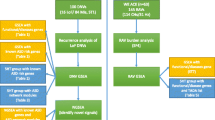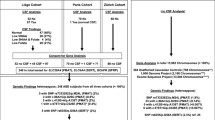Abstract
Autism is a neurodevelopmental disorder of unclear etiology. The consistent finding of platelet hyperserotonemia in a proportion of patients and its heritability within affected families suggest that genes involved in the serotonin system play a role in this disorder. The role in autism etiology of seven candidate genes in the serotonin metabolic and neurotransmission pathways and mapping to autism linkage regions (SLC6A4, HTR1A, HTR1D, HTR2A, HTR5A, TPH1 and ITGB3) was analyzed in a sample of 186 nuclear families. The impact of interactions among these genes in autism was assessed using the multifactor-dimensionality reduction (MDR) method in 186 patients and 181 controls. We further evaluated whether the effect of specific gene variants or gene interactions associated with autism etiology might be mediated by their influence on serotonin levels, using the quantitative transmission disequilibrium test (QTDT) and the restricted partition method (RPM), in a sample of 109 autistic children. We report a significant main effect of the HTR5A gene in autism (P = 0.0088), and a significant three-locus model comprising a synergistic interaction between the ITGB3 and SLC6A4 genes with an additive effect of HTR5A (P < 0.0010). In addition to the previously reported contribution of SLC6A4, we found significant associations of ITGB3 haplotypes with serotonin level distribution (P = 0.0163). The most significant models contributing to serotonin distribution were found for interactions between TPH1 rs4537731 and SLC6A4 haplotypes (P = 0.002) and between HTR1D rs6300 and SLC6A4 haplotypes (P = 0.013). In addition to the significant independent effects, evidence for interaction between SLC6A4 and ITGB3 markers was also found. The overall results implicate SLC6A4 and ITGB3 gene interactions in autism etiology and in serotonin level determination, providing evidence for a common underlying genetic mechanism and a molecular explanation for the association of platelet hyperserotonemia with autism.

Similar content being viewed by others
References
Abecasis GR, Cardon LR, Cookson WO (2000) A general test of association for quantitative traits in nuclear families. Am J Hum Genet 66:279–292
Abney M, McPeek MS, Ober C (2001) Broad and narrow heritabilities of quantitative traits in a founder population. Am J Hum Genet 68:1302–1307
Alarcón M, Cantor RM, Liu J, Gilliam TC, Geschwind DH (2002) Evidence for a language quantitative trait locus on chromosome 7q in multiplex autism families. Am J Hum Genet 70:60–71
American Psychiatric Association (1994) Diagnostic and statistical manual of mental disorders—fourth edition (DSM-IV). American Psychiatric Association, Washington DC
Auranen M, Vanhala R, Varilo T, Ayers K, Kempas E, Ylisaukko-Oja T, Sinsheimer JS, Peltonen L, Jarvela I (2002) A genomewide screen for autism-spectrum disorders: evidence for a major susceptibility locus on chromosome 3q25–27. Am J Hum Genet 71:777–790
Barrett S, Beck JC, Bernier R, Bisson E, Braun TA, Casavant TL, Childress D, Folstein SE, Garcia M, Gardiner MB, Gilman S, Haines JL, Hopkins K, Landa R, Meyer NH, Mullane JA, Nishimura DY, Palmer P, Piven J, Purdy J, Santangelo SL, Searby C, Sheffield V, Singleton J, Slager S et al (1999) An autosomal genomic screen for autism. Collaborative linkage study of autism. Am J Med Genet 88:609–615
Bradford Y, Haines J, Hutcheson H, Gardiner M, Braun T, Sheffield V, Cassavant T, Huang W, Wang K, Vieland V, Folstein S, Santangelo S, Piven J (2001) Incorporating language phenotypes strengthens evidence of linkage to autism. Am J Med Genet 105:539–547
Cantor RM, Kono N, Duvall JA, Alvarez-Retuerto A, Stone JL, Alarcón M, Nelson SF, Geschwind DH (2005) Replication of autism linkage: fine-mapping peak at 17q21. Am J Hum Genet 76:1050–1056
Clayton D (1999) A generalization of the transmission/disequilibrium test for uncertain-haplotype transmission. Am J Hum Genet 65:1170–1177
Coffey CS, Hebert PR, Ritchie MD, Krumholz HM, Gaziano JM, Ridker PM, Brown NJ, Vaughan DE, Moore JH (2004) An application of conditional logistic regression and multifactor dimensionality reduction for detecting gene–gene interactions on risk of myocardial infarction: the importance of model validation. BMC Bioinformatics 5:49
Cook EH Jr, Arora RC, Anderson GM, Berry-Kravis EM, Yan SY, Yeoh HC, Sklena PJ, Charak DA, Leventhal BL (1993) Platelet serotonin studies in hyperserotonemic relatives of children with autistic disorder. Life Sci 52:2005–2015
Coutinho AM, Oliveira G, Morgadinho T, Fesel C, Macedo TR, Bento C, Marques C, Ataíde A, Miguel T, Borges L, Vicente AM (2004) Variants of the serotonin transporter gene (SLC6A4) significantly contribute to hyperserotonemia in autism. Mol Psychiatry 9:264–271
Culverhouse R, Klein T, Shannon W (2004) Detecting epistatic interactions contributing to quantitative traits. Genet Epidemiol 27:141–152
Devlin B, Cook EH Jr, Coon H, Dawson G, Grigorenko EL, McMahon W, Minshew N, Pauls D, Smith M, Spence MA, Rodier PM, Stodgell C, Schellenberg GD (2005) Autism and the serotonin transporter: the long and short of it. Mol Psychiatry 10:1110–1116
Feise RJ (2002) Do multiple outcome measures require p-value adjustment? BMC Med Res Methodol 2:8
Good P (2000) Permutation tests. Springer, Berlin, Heidelberg New York
Grailhe R, Waeber C, Dulawa SC, Hornung JP, Zhuang X, Brunner D, Geyer MA, Hen R (1999) Increased exploratory activity and altered response to LSD in mice lacking the 5-HT(5A) receptor. Neuron 22:581–591
Greenberg BD, Tolliver TJ, Huang SJ, Li Q, Bengel D, Murphy DL (1999) Genetic variation in the serotonin transporter promoter region affects serotonin uptake in human blood platelets. Am J Med Genet 88:83–87
Griffiths R (1984) The abilities of young children. University of London Press, London
Hastie T, Tibshirani R, Friedman J (2001) The elements of statistical learning. Springer, Berlin Heidelberg New York
Janusonis S (2005) Statistical distribution of blood serotonin as a predictor of early autistic brain abnormalities. Theor Biol Med Model 2:27
Lahiri DK, Nurnberger JI Jr (1991) A rapid non-enzymatic method for the preparation of HMW DNA from blood for RFLP studies. Nucleic Acids Res 19:5444
Lesch KP, Bengel D, Heils A, Sabol SZ, Greenberg BD, Petri S, Benjamin J, Muller CR, Hamer DH, Murphy DL (1996) Association of anxiety-related traits with a polymorphism in the serotonin transporter gene regulatory region. Science 274:1527–1531
Lord C, Rutter M, Le Couteur A (1994) Autism diagnostic interview-revised: a revised version of a diagnostic interview for caregivers of individuals with possible pervasive developmental disorders. J Autism Dev Disord 24:659–685
Lord C, Cook EH, Leventhal BL, Amaral DG (2000) Autism spectrum disorders. Neuron 28:355–363
McBride PA, Anderson GM, Hertzig ME, Sweeney JA, Kream J, Cohen DJ, Mann JJ (1989) Serotonergic responsivity in male young adults with autistic disorder. Results of a pilot study. Arch Gen Psychiatry 46:213–221
Meltzer HY, Arora RC (1988) Genetic control of serotonin uptake in blood platelets: a twin study. Psychiatry Res 24:263–269
Moore JH (2003a) In: Raidl G et al (eds) Lecture notes in computer science, vol 2611. Springer, Berlin Heidelberg New York, pp 99–106
Moore JH (2003b) The ubiquitous nature of epistasis in determining susceptibility to common human diseases. Hum Hered 56:73–82
Moore JH (2004) Computational analysis of gene-gene interactions using multifactor dimensionality reduction. Expert Rev Mol Diagn 4:795–803
Moore JH (2005) A global view of epistasis. Nat Genet 37:13–14
Moore JH, Gilbert JC, Tsai CT, Chiang FT, Holden T, Barney N, White BC (2006) A flexible computational framework for detecting, characterizing, and interpreting statistical patterns of epistasis in genetic studies of human disease susceptibility. J Theor Biol 241:252–261
Oatway MA, Chen Y, Bruce JC, Dekaban GA, Weaver LC (2005) Anti-CD11d integrin antibody treatment restores normal serotonergic projections to the dorsal, intermediate, and ventral horns of the injured spinal cord. J Neurosci 25:637–647
Ober C, Abney M, McPeek MS (2001) The genetic dissection of complex traits in a founder population. Am J Hum Genet 69:1068–1079
Rees S, den Daas I, Foord S, Goodson S, Bull D, Kilpatrick G, Lee M (1994) Cloning and characterisation of the human 5-HT5A serotonin receptor. FEBS Lett 355:242–246
Richdale AL, Prior MR (1995) The sleep/wake rhythm in children with autism. Eur Child Adolesc Psychiatry 4:175–186
Ritchie MD, Hahn LW, Roodi N, Bailey LR, Dupont WD, Parl FF, Moore JH (2001) Multifactor-dimensionality reduction reveals high-order interactions among estrogen-metabolism genes in sporadic breast cancer. Am J Hum Genet 69:138–147
Sajid M, Vijayan KV, Souza S, Bray PF (2002) PlA polymorphism of integrin beta 3 differentially modulates cellular migration on extracellular matrix proteins. Arterioscler Thromb Vasc Biol 22:1984–1989
Schopler E, Reichler RJ, Renner BR (1988) The childhood autism rating scale (CARS). Western Psychological Services, Los Angeles
Sham PC, Curtis D (1995) An extended transmission/disequilibrium test (TDT) for multi-allele marker loci. Ann Hum Genet 59:323–336
Sprouse J, Reynolds L, Braselton J, Schmidt A (2004) Serotonin-induced phase advances of SCN neuronal firing in vitro: a possible role for 5-HT5A receptors? Synapse 54:111–118
Stephens M, Smith NJ, Donnelly P (2001) A new statistical method for haplotype reconstruction from population data. Am J Hum Genet 68:978–989
Stone JL, Merriman B, Cantor RM, Yonan AL, Gilliam TC, Geschwind DH, Nelson SF (2004) Evidence for sex-specific risk alleles in autism spectrum disorder. Am J Hum Genet 75:1117–1123
Sun HS, Fann CS, Lane HY, Chang YT, Chang CJ, Liu YL, Cheng AT (2005) A functional polymorphism in the promoter region of the tryptophan hydroxylase gene is associated with alcohol dependence in one aboriginal group in Taiwan. Alcohol Clin Exp Res 29:1–7
Sutcliffe JS, Delahanty RJ, Prasad HC, McCauley JL, Han Q, Jiang L, Li C, Folstein SE, Blakely RD (2005) Allelic heterogeneity at the serotonin transporter locus (SLC6A4) confers susceptibility to autism and rigid-compulsive behaviors. Am J Hum Genet 77:265–279
Thornton-Wells TA, Moore JH, Haines JL (2004) Genetics, statistics and human disease: analytical retooling for complexity. Trends Genet 20:640–647
Velez DR, White BC, Motsinger AA, Bush WS, Ritchie MD, Williams SM, Moore JH (2006) A balanced accuracy metric for epistasis modeling in imbalanced datasets using multifactor dimensionality reduction. Genet Epidemiol (in press)
Vijayan KV, Liu Y, Sun W, Ito M, Bray PF (2005) The Pro33 isoform of integrin beta3 enhances outside-in signaling in human platelets by regulating the activation of serine/threonine phosphatases. J Biol Chem 280:21756–21762
Weiss LA, Veenstra-Vanderweele J, Newman DL, Kim SJ, Dytch H, McPeek MS, Cheng S, Ober C, Cook EH Jr, Abney M (2004) Genome-wide association study identifies ITGB3 as a QTL for whole blood serotonin. Eur J Hum Genet 12:949–954
Weiss LA, Abney M, Cook EH Jr, Ober C (2005a) Sex-specific genetic architecture of whole blood serotonin levels. Am J Hum Genet 76:33–41
Weiss LA, Abney M, Parry R, Scanu AM, Cook EH Jr, Ober C (2005b) Variation in ITGB3 has sex-specific associations with plasma lipoprotein(a) and whole blood serotonin levels in a population-based sample. Hum Genet 117:81–87
Weiss LA, Kosova G, Delahanty RJ, Jiang L, Cook EH Jr, Ober C, Sutcliffe JS (2006a) Variation in ITGB3 is associated with whole-blood serotonin level and autism susceptibility. Eur J Hum Genet 14:923–931
Weiss LA, Ober C, Cook EH Jr (2006b) ITGB3 shows genetic and expression interaction with SLC6A4. Hum Genet 120:93–100
Whitaker-Azmitia PM (2005) Behavioral and cellular consequences of increasing serotonergic activity during brain development: a role in autism? Int J Dev Neurosci 23:75–83
Zill P, Buttner A, Eisenmenger W, Moller HJ, Ackenheil M, Bondy B (2005) Analysis of tryptophan hydroxylase I and II mRNA expression in the human brain: A post-mortem study. J Psychiatr Res doi:10.1016/j.jpsychires.2005.05.004
Acknowledgments
We thank the autistic patients, their relatives and the healthy blood donors for their collaboration in this study. This work was supported by a Portuguese grant from the Fundação para a Ciência e a Tecnologia (FCT) (POCTI/39636/ESP/2001). Ana M. Coutinho was supported by a grant from FCT (SFRH/BD/3145/2000) and from the Fundo Social Europeu (III Quadro Comunitário de Apoio).
Author information
Authors and Affiliations
Corresponding author
Electronic supplementary material
Below is the link to the electronic supplementary material.
439_2006_301_MOESM1_ESM.doc
Supplementary Table S1 Polymorphisms studied and respective reference or primer sequences used for amplification (DOC 420 kb)
Rights and permissions
About this article
Cite this article
Coutinho, A.M., Sousa, I., Martins, M. et al. Evidence for epistasis between SLC6A4 and ITGB3 in autism etiology and in the determination of platelet serotonin levels. Hum Genet 121, 243–256 (2007). https://doi.org/10.1007/s00439-006-0301-3
Received:
Accepted:
Published:
Issue Date:
DOI: https://doi.org/10.1007/s00439-006-0301-3




